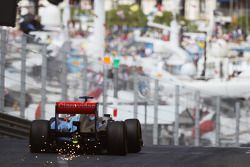Titanium skids for safety, not sparks - FIA
FIA insists the new skid block rules are in fact to "ensure they are made from a lighter material and are better contained".

XPB Images






Jul.15 (GMM) F1 is not mandating titanium be fitted underneath next year's cars solely to create sparks, the governing body insists.
After tests on a couple of cars were carried out during Austrian Grand Prix practice last month, the FIA has now committed to introducing new rules for 2015.
It was reported that the sole reason for adding titanium to the skid blocks was to create the kind of spectacular sparks that characterised the 80s.
But, in the wake of criticism that F1 is too often reverting to 'artificial' rules to inject excitement, the FIA insists the new skid block rules are in fact to "ensure they are made from a lighter material and are better contained".
"The skids have formerly been made of a heavy metal, which has been very resistant to wear, and they (the teams) put the skids around the points in the plank where thickness is measured," said F1 race director Charlie Whiting.
"This metal is extremely heavy and when pieces detach they can be extremely harmful. We saw two punctures in Spa previously because of bits of this metal that lay in a kerb and caused damage," he added. "In a worst case scenario they could fly off and hit someone."
So Whiting said the FIA is mandating the use of titanium next year primarily for safety reasons.
"Secondly," he explained, "the titanium wears some two to 2.5 times more quickly than the metal currently used. Thus cars will have to be run a little bit higher to manage wear and teams won't be able to drag them on the ground quite as much as they have in the past.
"The third effect is that you will see a lot more sparks, which some people think will look a little more spectacular," Whiting acknowledged.
Be part of Motorsport community
Join the conversationShare Or Save This Story
Subscribe and access Motorsport.com with your ad-blocker.
From Formula 1 to MotoGP we report straight from the paddock because we love our sport, just like you. In order to keep delivering our expert journalism, our website uses advertising. Still, we want to give you the opportunity to enjoy an ad-free and tracker-free website and to continue using your adblocker.














Top Comments